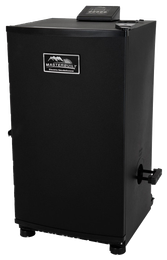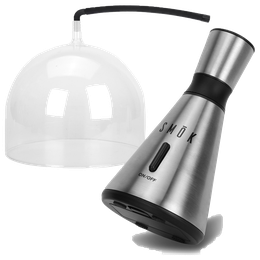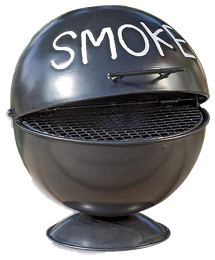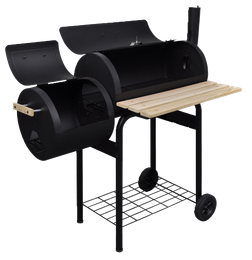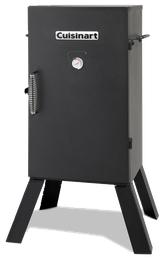FREE shipping on orders over $49!* Details
Smokers
14 Results
Sort by:
Price
14 Results
Best Seller
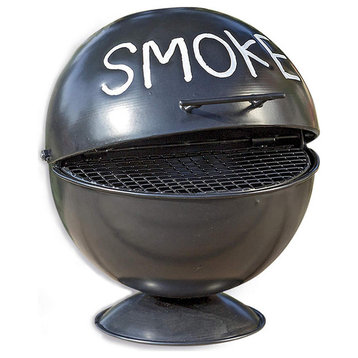
Smoke Ashtray, FauxGrill with Lidded Dome, Pedestal Base, 6"by Whole House Worlds(118)
SALE
$31$35
Strike up party panache when you entertain with our Smoke Ashtray. Cleverly disguised as a table top barbecue, complete with a hinged lifting lid and an inside grill,. This clean and neat solution for guests allows them to catch their ashes in style. This piece measures exactly as follows: 5 1/8 D x 5 1/8 W x 6 H Inches. Made of durable iron, and embellished with the word SMOKE across the lid, this dark metal lidded ashtray is mounted atop a pedestal for easy placement upon table tops. Lift the lid of this sleek and clever piece and reveal a grill to rest smoking cigarettes on. Keep it closed to prevent wind from blowing ashes, lingering smoke and embers. Ideal for outdoor entertaining, BBQ, picnics and garden parties. AN IDEAL GIFT, it's a perfect present for smoking aficionados. Enjoy! By Whole House Worlds Welcome to the product line of Whole House Worlds. The New York based company offers high quality, stylish products for every room in the house, and beyond. From the kitchen, to the living room, to the bedroom, dining room, home office, closet and garden: Our criteria are comfort, quality, style and value.
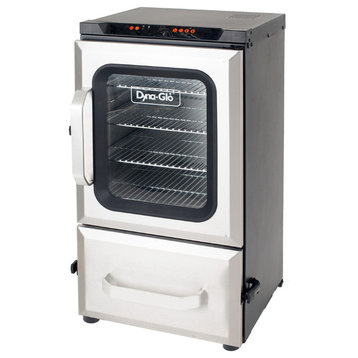
Dyna-Glo Digital Bluetooth Electric Smoker, 30"by GHP GROUP, INC(494)
$323
Free Shipping
Bring the classic art of barbecue into the future with the 30" Bluetooth Digital Electric Smoker from Dyna-Glo. Digitally set and monitor your cook time and temperature with your smart phone or tablet, using the smokers Bluetooth connectivity. With the digitally-controlled, integrated meat thermometer, you can keep an eye on the foods internal temperature without opening the door, and relax knowing the smoker will turn off when the meat reaches your desired temperature. Designed for easy access and a simplified process, this smoker will have you serving up ribs, sausages and more in no time. 2
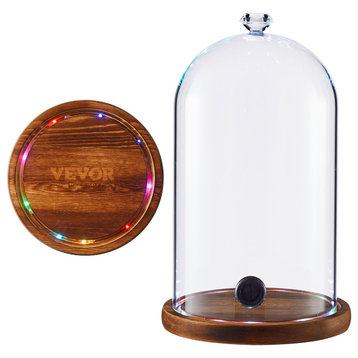
VEVOR Smoking Gun Accessory Glass Cloche Dome Cover for Smoke Infuser Wood Baseby VEVOR
Reliable Glass & Optimum Size: Thick glass is adopted by this smoke infusion accessory encasing your culinary delights, providing a clear view of the smoky transformation within. The size of the enclosure is ideal for versatile use, accommodating various types of glassware and dishes to meet your requirements.
Exquisite Details: Our glass smoke cloche has a portable knob that ensures effortless handling, while the wooden LED base adds a touch of natural allure. The sealing rubber port ensures a secure closure, locking in flavors and aromas for a perfect smoky infusion.
Various Application: Surprise your friends and loved ones with a gift they'll cherish, a stunning addition to their home decor, or a mesmerizing centerpiece at your next party. The glass dome cover caters to all your culinary creations, whether it's cocktails, appetizers, desserts, or main courses.
A Breeze to Operate: Our smoking cloche dome cover is a necessary accessory for your cocktail smoker. From the preparation of your food to the presentation under the cloche, the steps are simple, yet the results are extraordinary.
$43
Free Shipping
- Ideal Cloche for your Smoking Gun
- Brighten up your cocktail with the mesmerizing glow of LED lights. Convenient battery-powered operation for hassle-free use.
Features & Details
LED Cloche: This smoking cloche boasts rainbow LED lights which creates a unique visual effect while smoking your drinks. Step into a world of sensory delight as LED lights cast a captivating glow over your creations, setting the stage for an unforgettable dining spectacle. For your convenience, three AAA batteries are included.Reliable Glass & Optimum Size: Thick glass is adopted by this smoke infusion accessory encasing your culinary delights, providing a clear view of the smoky transformation within. The size of the enclosure is ideal for versatile use, accommodating various types of glassware and dishes to meet your requirements.
Exquisite Details: Our glass smoke cloche has a portable knob that ensures effortless handling, while the wooden LED base adds a touch of natural allure. The sealing rubber port ensures a secure closure, locking in flavors and aromas for a perfect smoky infusion.
Various Application: Surprise your friends and loved ones with a gift they'll cherish, a stunning addition to their home decor, or a mesmerizing centerpiece at your next party. The glass dome cover caters to all your culinary creations, whether it's cocktails, appetizers, desserts, or main courses.
A Breeze to Operate: Our smoking cloche dome cover is a necessary accessory for your cocktail smoker. From the preparation of your food to the presentation under the cloche, the steps are simple, yet the results are extraordinary.
Specifications
- Item Model Number: 1530-1
- Voltage: DC 4.5V
- Power: 1W
- Material: Glass, Wood
- Net Weight: 6.6 lbs / 3 kg
- Package Content
- 1 x Smoking Cloche
- 3 x AAA Batteries (in the base)
- 1 x User Manual
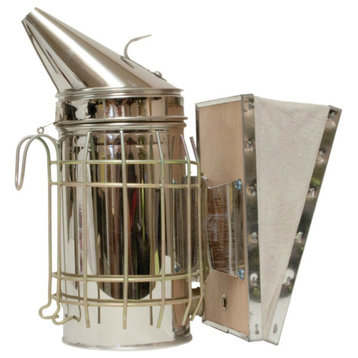
Harvest Lane Honey SMK3-101 Standard Smokerby Harvest Lane Honey, LLC(8)
$63
Free Shipping
For the backyard beekeeper. Use stainless steel medium bee smoker to help soothe the colony, relax your hive, and prevent aggressive bees. Helps to disguise your pheromones and sooth the bees. Includes a heat shield and side hook, with leather bellows.
- For the backyard beekeeper
- Made with leather bellows and galvanized steel
- Helps to disguise your pheromones and sooth the bees
- Has a guard in place to help protect your hands
- Please use caution when using.
Best Seller
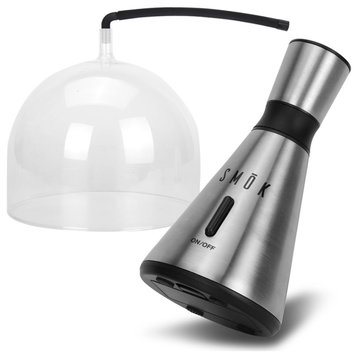
Modern Home SMŌK Food and Drink Smoke Infuser w/Clear Dome Enclosure, Hickory/Aby Vandue Corporation(46)
$52
Free Shipping
From Modern Home comes an exclusive design for the ultimate foodie or whiskey aficionado. The SMŌK Food and Drink Smoke Infuser allows you to effortlessly infuse foods and drinks using natural applewood, hickory or other natural woods without adding extra heat. This versatile smoker quickly adds a smoky flavor to food before or after cooking. To operate, simply place smoking wood chips into the burning chamber, ignite and then place the food or drink under the clear dome enclosure for quick infusing. You can also detach the dome and run the 10" flexible hose into any other type container that will seal in the smoky flavor such as resealable bags, cocktail shakers, bowls and more. The heat is contained within the smoking chamber resulting in a cooler smoke at release. Gentle enough to use on delicate vegetables and fruits without changing the texture or raising the temperature. Perfect for cocktails, whiskey, or martinis and great on foods like steaks, fish, poultry, vegetables, fruits, nuts and more. Wood does not require any pre-soaking. Ready to use. Wood chips not included. Requires 4 AA batteries (not included). Infuser measures 3.25" x 3.25" x 6.1" tall. Clear acrylic dome measures 7.9" in diameter by 7.5" tall (6" tall without handle). Designed for both home and commercial use.
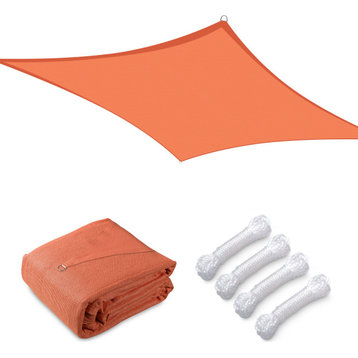
Yescom 16x16 Ft 97% UV Block Square Sun Shade Sail HDPE Canopy Patio Backyardby Yescom(1)
$48
Free Shipping
Features:
- Decorative & Effective Shading - 16x16 ft Square Sun Shade Sail, gorgeous color to attract attention, a beautiful decoration for backyard, balcony, terrace, porch, pergola, poolside, deck and a perfect awning sunscreen shade to cool down patio for outdoor party with friends or families
- HDPE Reduces Heat Transfer - Made by 100% brand new 185GSM HDPE material to efficiently reduce the temperature under sail about 50°F (10°C), excellent breathability to allow breeze to pass through, offers a cool and airy shelter on hot days
- 97% UV Block Protection - Effectively blocks 97% of harmful UV ray to protect your delicate skin from blazing sun, creating a comfortable area in summer time
- Easy Assembly & Maintenance - Hanging ropes included for convenient installation by simply connecting stainless steel D-shape rings and the mounting points; Foldable design for space-saving storage, washable sail for easy cleaning
- Durable in Use - Triple stitched seam reinforces the edge to prevent fraying and ripping; Curved square shape helps the sail to keep tight; Heavy-duty nylon ropes included; Anti-ager composition added for long time service; 5-year warranty for quality issue
Specifications:
- Overall Dimension(LxW): 16ft x 16ft (487.7 x 487.7 cm)
- D-shape Ring Dimension(LxWxH): 1 9/16" x 1 7/16" x 3/16" (4 x 3.7 x 0.4 cm)
- Rope Length: 13 1/12ft (400 cm)
- Fabric Weight: 185 GSM
- Net Weight: 7.9 Lbs (3.6 kg)
Package Contents:
- 1x Sun Shade Sail
- 4x Ropes
- 1x Manual
Notice:
- Please allow approx. 4" measuring deviation due to manual measurement and flexibility of fabric. Each side may be 4" longer than the related product size showed on the listing.
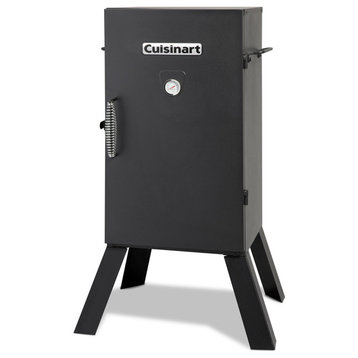
30" Electric Vertical Smokerby Cuisinart(5848)
SALE
$261$313
Free Shipping
Get that smoky flavor without using a traditional charcoal smoker! The Cuisinart 30-inch electric vertical smoker is lightweight and user-friendly - great for beginners and seasoned users alike. Set the internal temperature to the exact degree, and the smoker will do all the hard work. Three chrome-coated racks provide 548 square inches of cooking space which is spacious enough to smoke meat for a large group of people. The removable water pan and wood chip tray allow for quick start-ups and clean-ups. Convenient and easy to use, you�ll enjoy smoking meats, fish, cheese, and more with Cuisinart's electric smoker.
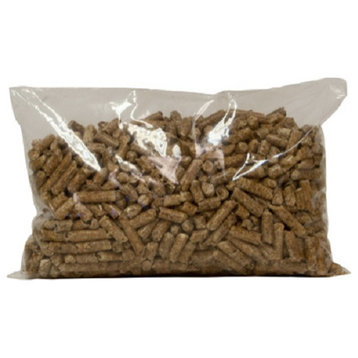
Harvest Lane Honey SMK-102 Smoker Pellets, 1 Lbby Harvest Lane Honey(11)
$21
Free Shipping
1 lb. of Smoker Pellets. Used as an easy fuel source for all Harvest Lane Honey smokers. Use 1 Tablespoon of pellets for each use. We have found it helpful to initially light a single pellet and then place it inside the filled smoker.
- Pellets are most easily lite by using lighting torch
- Made for a long lasting burn
- It will be able to be used for multiple inspections
- Easy & convenient to use, use caution when using.
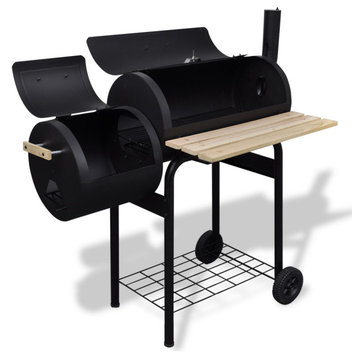
Outdoor BBQ Charcoal Offset Smokerby AffordableVariety
$250
Free Shipping
This smoker, consisting of generous cooking chamber and robust side firebox, allows you to conveniently grill, smoke and flavor your food. The perfectly sealed, thick metal body gives our smoker excellent heat retention and heat distribution characteristics.
The air outlets will help you adjust the air flow while the smoke stack damper controls the amount of smoke. You can monitor the temperature in the chamber with an integrated thermometer. The smoker also contains a shelf in front and storage shelf below where you can place spices, ingredients, utensils and other barbecue essentials.
Equipped with 2 wheels, it can be easily moved around for outdoor parties, picnics and gatherings.
The air outlets will help you adjust the air flow while the smoke stack damper controls the amount of smoke. You can monitor the temperature in the chamber with an integrated thermometer. The smoker also contains a shelf in front and storage shelf below where you can place spices, ingredients, utensils and other barbecue essentials.
Equipped with 2 wheels, it can be easily moved around for outdoor parties, picnics and gatherings.
- Color: Black
- Material: Steel frame + wood shelf
- Overall size: 41" x 23" x 45" (L x W x H)
- Cooking Chamber: 12" x 24" (Diam. x L)
- Side firebox: 12" x 12" (Diam. x L)
- Thermometer included: Yes
- Smoke stack damper included: Yes
- Suitable for charcoal or wood
Masterbuilt 20071117 Digital Electric Smoker, Black, 30"by Atlas Supply Chain(125)
$578
Free Shipping
Highlights:
- Size: 30"
- Color: Black
- Material: Steel
- Ignition type: Electrical
- Digital panel controls on/off, temperature and time
- 4 chrome-coated smoker racks
- Digital temperature control, grease pan, locking lid/door
- Patented side wood chip loading system - add chips without opening the smoker door
- Integrated thermostat temperature control for even, consistent smoking
- Fully-insulated smoker body
- 800-Watt heating element for even, consistent smoking
- Adjustable air damper for smoke control
- Removable drip pan for easy cleanup
- CSA Certified
16" Vertical Charcoal Smokerby Cuisinart(1685)
$131
Free Shipping
16" Vertical Charcoal Smoker
Now you can smoke all of your favorite foods, including cheese, vegetables and meats with the Cuisinart vertical 16-inch charcoal smoker. With two round 16-inch cooking grates that can be stacked inside the smoking chamber, this smoker can accommodate just about any food you want to smoke. Working it is as simple as lighting the charcoal, filling up the water bowl, and then adjusting the air vents to control the amount of heat and smoke leaving the chamber. The vertical barrel design makes it easy to keep a consistent temperature with minimal adjustments. Lift the lid for easy access to foods as they smoke. Cuisinart's vertical smoker is simple to maintain and clean-up is easy. Plus, the vertically hinged door provides easy access to the water bowl and charcoal.
Now you can smoke all of your favorite foods, including cheese, vegetables and meats with the Cuisinart vertical 16-inch charcoal smoker. With two round 16-inch cooking grates that can be stacked inside the smoking chamber, this smoker can accommodate just about any food you want to smoke. Working it is as simple as lighting the charcoal, filling up the water bowl, and then adjusting the air vents to control the amount of heat and smoke leaving the chamber. The vertical barrel design makes it easy to keep a consistent temperature with minimal adjustments. Lift the lid for easy access to foods as they smoke. Cuisinart's vertical smoker is simple to maintain and clean-up is easy. Plus, the vertically hinged door provides easy access to the water bowl and charcoal.
Contemporary End Table, Geometric Metal Base With Clear Glass Top, Sand Blackby Decor Love
$449
Free Shipping
- Includes: one (1) end table
- Contemporary style; Wide and ample tabletop
- Materials: Steel, Tempered Glass
- Features: Geometric base pairs well in contemporary and modern style homes
- Item Measurements: 23 inches high x 24 inches wide x 24 inches deep
Vertical 18" Charcoal Smokerby Cuisinart(1706)
$200
Free Shipping
Now you can smoke all of your favorite foods, including cheese, vegetables and meats with the Cuisinart vertical 18-inch charcoal smoker. With two round 18-inch cooking grates that can be stacked inside the smoking chamber, this smoker can accommodate just about any food you want to smoke. Working it is as simple as lighting the charcoal, filling up the water bowl, and then adjusting the air vents to control the amount of heat and smoke leaving the chamber. The vertical barrel design makes it easy to keep a consistent temperature with minimal adjustments. Lift the lid for easy access to foods as they smoke. Cuisinart's vertical smoker is simple to maintain and clean-up is easy. Plus, the vertically hinged door provides easy access to the water bowl and charcoal.
Smoker Mirage Blackby Witt Industries
$183
Free Shipping
- Smoker Mirage Black "Set of 1Descriptions:
- Product Dimension: 16" x 39"
If you’re a meat lover, nothing satisfies quite like sinking your teeth into a moist and tender cut of beef, poultry or fish. While you can enjoy such delights by dining out, you can just as easily create them at home with a smoker. With BBQ smokers, you can cook up flavor-infused brisket, chicken, ribs, pulled pork, fish and much more. Who wouldn’t want to come over for dinner and enjoy a smoky, barbecued meal? Whether you’re cooking in a competition or whipping up some home-smoked eats for the family, take a peek at these helpful tips to get started:
You’ve got your sights set on a mouthwatering barbecue recipe and it’s time to get smoking. When it comes to buying a smoker grill, there are a few items that you simply must have. These include easy to use temperature controls, thick metal, seals and insulation, a design that provides even heat, dampers that are easy to operate, and, of course, safety features like locking wheels. You’ll also want to consider what styles are out there and choose the one that best fits your needs:
• Ceramic: Also known as a kamado grill, these ceramic smokers date back thousands of years. Their unique design lets you do much more than smoke meats — you can grill and even bake pizzas with a kamado grill. They’re easy to use and require less fuel than pellet smokers, making them a great choice for beginners. Look for a model with a thick ceramic wall and hardware that resists corrosion.
• Pellet: Pellet smokers use wood pellets to heat and infuse meats or fish with that oh-so delicious smoky barbecue flavor. They’re the easiest style to use, especially since most models feature an electronic control that automatically adjusts the temperature and feeds the pellets onto the burner. Look for a pellet smoker made from thick-gauge steel that’s coated with a corrosion-resistant finish. A high-end model should also feature grease drip trays and electronic controls.
• Water: A water smoker uses heat from a fire plus steam from the water to cook your meat and keep it moist at the same time. They tend to be easy to use and do a great job of infusing meat with that great smoky flavor. You can find these working hard at most barbecue competitions.
• Horizontal: Also known as an offset smoker, this design features a firebox that’s attached to the side of the main cooking chamber. They’re great for smoking large amounts of meat and fish, though you may find that cuts placed closer to the firebox finish cooking faster than those that are farther away. If you do opt for an offset smoker, make sure you purchase one that’s made from thick metal and has tight-fitting doors and dampers. Some more expensive models may also feature a duct system that forces hot air through the length of the smokebox to cook food evenly. Another perk of more expensive models is the placement of the chimney on the same side as the firebox, which pulls the hot air across the top of your food.
• Drum: Also known as a barrel smoker, these resemble a large, industrial-looking drum. They feature ample space for smoking large quantities of meat or fish, and the design is perfect for allowing the heat and smoke to rise and evenly cook your food. Some designs even feature hooks to hang your meat on.
So you’re ready to get started smoking, are you? If you’re a beginner or even a full-fledged grill master, we’ve got some great tips that will have you enjoying a savory, smoky meal in no time:
• Preparing your fuel: If you’re planning on using wood chunks, it’s important to prep them before you begin smoking by soaking them in water for at least an hour. If you’re using wood chips or aromatic woods, you can soak these for 30 minutes instead of a full hour. Once they’re done soaking, shake out all excess water before adding them to your fire. If you’re using charcoal, refrain from adding starter fluid as this can add an unpleasant chemical taste to your foods.
• Add in some water: Water is important for keeping meat and fish tender. Some smokers feature water pans, and if yours has one, you can play around with adding marinades, barbecue sauce, herbs and spices, juice and even wine or beer to your water. It’s important to keep the water pan full, so if you’re smoking a large quantity of meat or larger cuts, be sure to check the water levels and add more if needed. An easy way to add more water is to use a watering can.
• Get smokin’: Once your smoker is fully preheated, go ahead and place your food in the center of the grate just above the water pan if you have one. As they say, a watched pot never boils, so avoid peeking in at your meal while it’s cooking. This can release smoke and heat, which slows down your cooking process. A pro tip you may not have considered is to smoke your meats up to two days prior to serving. This allows that irresistible smoky flavor to build up and become richer as your food sits in the refrigerator.
• Check temperatures: Make sure you have a meat thermometer on hand to ensure your food is done but not overcooked. Simply eyeing up your finished product may be misleading since smoked foods can be pink or red even when they’re fully cooked.
• Enjoy your meal: Sit down with family and friends and savor your hard work. It’s a great idea to keep track of the different ingredients, wood types and amounts used plus your results in order to duplicate successful recipes or try new combinations in the future.
There are a few go-to choices when it comes to wood pellets, but you shouldn’t be scared to try new combinations. Here are a few different choices you might try next time you get busy smoking:
• Mesquite: This wood is great for most meats and vegetables. It has a sweet, delicate flavor that’s similar to hickory. It does burn hot, so use caution.
• Maple: If you’re smoking ham, veggies or poultry, maple is a great choice. It infuses your food with a somewhat sweet and smoky flavor.
• Alder: The delicate flavors this wood provides are perfect for fish like salmon, sturgeon and swordfish. It’s also a great choice for pork and chicken.
• Wine barrel chips: You can add a uniquely wine-like, oaky flavor to beef, chicken and turkey with these wood chips. Try looking for some in specialty food stores or online.
• Herbs and spices: Try garlic, mint, citrus peels, cinnamon sticks, bay leaves and rosemary for a wide variety of flavors for veggies, fish and smaller cuts of meat.
What kinds of BBQ smokers are available?
You’ve got your sights set on a mouthwatering barbecue recipe and it’s time to get smoking. When it comes to buying a smoker grill, there are a few items that you simply must have. These include easy to use temperature controls, thick metal, seals and insulation, a design that provides even heat, dampers that are easy to operate, and, of course, safety features like locking wheels. You’ll also want to consider what styles are out there and choose the one that best fits your needs:
• Ceramic: Also known as a kamado grill, these ceramic smokers date back thousands of years. Their unique design lets you do much more than smoke meats — you can grill and even bake pizzas with a kamado grill. They’re easy to use and require less fuel than pellet smokers, making them a great choice for beginners. Look for a model with a thick ceramic wall and hardware that resists corrosion.
• Pellet: Pellet smokers use wood pellets to heat and infuse meats or fish with that oh-so delicious smoky barbecue flavor. They’re the easiest style to use, especially since most models feature an electronic control that automatically adjusts the temperature and feeds the pellets onto the burner. Look for a pellet smoker made from thick-gauge steel that’s coated with a corrosion-resistant finish. A high-end model should also feature grease drip trays and electronic controls.
• Water: A water smoker uses heat from a fire plus steam from the water to cook your meat and keep it moist at the same time. They tend to be easy to use and do a great job of infusing meat with that great smoky flavor. You can find these working hard at most barbecue competitions.
• Horizontal: Also known as an offset smoker, this design features a firebox that’s attached to the side of the main cooking chamber. They’re great for smoking large amounts of meat and fish, though you may find that cuts placed closer to the firebox finish cooking faster than those that are farther away. If you do opt for an offset smoker, make sure you purchase one that’s made from thick metal and has tight-fitting doors and dampers. Some more expensive models may also feature a duct system that forces hot air through the length of the smokebox to cook food evenly. Another perk of more expensive models is the placement of the chimney on the same side as the firebox, which pulls the hot air across the top of your food.
• Drum: Also known as a barrel smoker, these resemble a large, industrial-looking drum. They feature ample space for smoking large quantities of meat or fish, and the design is perfect for allowing the heat and smoke to rise and evenly cook your food. Some designs even feature hooks to hang your meat on.
How can I get the most out of my new smoker grill?
So you’re ready to get started smoking, are you? If you’re a beginner or even a full-fledged grill master, we’ve got some great tips that will have you enjoying a savory, smoky meal in no time:
• Preparing your fuel: If you’re planning on using wood chunks, it’s important to prep them before you begin smoking by soaking them in water for at least an hour. If you’re using wood chips or aromatic woods, you can soak these for 30 minutes instead of a full hour. Once they’re done soaking, shake out all excess water before adding them to your fire. If you’re using charcoal, refrain from adding starter fluid as this can add an unpleasant chemical taste to your foods.
• Add in some water: Water is important for keeping meat and fish tender. Some smokers feature water pans, and if yours has one, you can play around with adding marinades, barbecue sauce, herbs and spices, juice and even wine or beer to your water. It’s important to keep the water pan full, so if you’re smoking a large quantity of meat or larger cuts, be sure to check the water levels and add more if needed. An easy way to add more water is to use a watering can.
• Get smokin’: Once your smoker is fully preheated, go ahead and place your food in the center of the grate just above the water pan if you have one. As they say, a watched pot never boils, so avoid peeking in at your meal while it’s cooking. This can release smoke and heat, which slows down your cooking process. A pro tip you may not have considered is to smoke your meats up to two days prior to serving. This allows that irresistible smoky flavor to build up and become richer as your food sits in the refrigerator.
• Check temperatures: Make sure you have a meat thermometer on hand to ensure your food is done but not overcooked. Simply eyeing up your finished product may be misleading since smoked foods can be pink or red even when they’re fully cooked.
• Enjoy your meal: Sit down with family and friends and savor your hard work. It’s a great idea to keep track of the different ingredients, wood types and amounts used plus your results in order to duplicate successful recipes or try new combinations in the future.
What types of woods work best in smokers?
There are a few go-to choices when it comes to wood pellets, but you shouldn’t be scared to try new combinations. Here are a few different choices you might try next time you get busy smoking:
• Mesquite: This wood is great for most meats and vegetables. It has a sweet, delicate flavor that’s similar to hickory. It does burn hot, so use caution.
• Maple: If you’re smoking ham, veggies or poultry, maple is a great choice. It infuses your food with a somewhat sweet and smoky flavor.
• Alder: The delicate flavors this wood provides are perfect for fish like salmon, sturgeon and swordfish. It’s also a great choice for pork and chicken.
• Wine barrel chips: You can add a uniquely wine-like, oaky flavor to beef, chicken and turkey with these wood chips. Try looking for some in specialty food stores or online.
• Herbs and spices: Try garlic, mint, citrus peels, cinnamon sticks, bay leaves and rosemary for a wide variety of flavors for veggies, fish and smaller cuts of meat.







